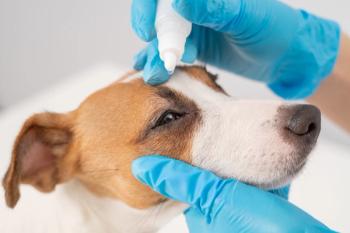
Paws and wobbles: What a dog’s gait can say about their nervous system
Learn about wobbler syndrome, symptoms, diagnosis, and treatment
What does it mean when a canine patient has a constant wobble in their gait? In dogs, wobbler syndrome is a painful and debilitating neurological condition that impacts the cervical or neck region of the spine.1 Joseph Mankin, DVM, clinical professor at the Texas A&M College of Veterinary Medicine & Biomedical Sciences discussed signs, diagnosis, and treatment for wobbler syndrome, in a Texas A&M news release.2
Canines with wobbler syndrome will exhibit a “wobble” in their gait, hence the disease’s name. These dogs will experience pain due to pressure on their spinal cord. Moreover, this pressure will affect the nervous system, which in turn affects the signals that are sent to the brain.2
There are 2 forms of this syndrome: disc-associated wobbler syndrome (DAWS), and bony-associated cervical spondylomyelopathy (BACS).1 The latter is characterized by the occurrence of an intervertebral disc herniation. Meanwhile, in canines with BACS, a bony malformation will lead to compression of the spinal cord and, in certain instances, on the nerves as well. This pressure can create problems with the dog’s walking ability. If nerve roots are involved, it can cause the dog pain.1
Mankin explained which dogs are most vulnerable to each form of wobbler syndrome. “In young, giant breed dogs such as Great Danes, there is bone proliferation, or rapid growth, in the part of the spine that makes up the neck, leading to compression of the spinal cord,” he said, in a news release.2 “In older dogs, we see degeneration of the intervertebral disc, which also leads to compression of the spinal cord.”
According to Texas A&M, great danes, Dobermans, German shepherds, rottweilers, and weimaraners are most often impacted by the disease, although it can affect all breeds,2 especially large or giant breeds.1
Signs and diagnosis
Around 5% of dogs with wobbler syndrome experience sudden paralysis in all 4 limbs, according to a report.1 Symptoms become more severe as the syndrome progresses, per a release.2 Signs that indicate wobbler syndrome include2:
- Difficulty getting up, leading to an appearance of stiffness
- Difficulty walking, leading to stumbling
- Dragging of feet, leading to nail wear
- Semi or complete paralysis
In the initial stages of the disease, canines may only have a wobbly gait in their back legs. These dogs may also walk with their head down due to neck pain and have muscle loss near the shoulders. When walking, canines with the syndrome may take short strides, exhibit an increased extension of all 4 limbs, and/or be spastic or very weak in the front limbs.1
According to Mankin, the biggest sign of the disease is in the source of the dog’s immediate pain. “Since this is a condition of the neck, the clinical signs will progress to affect both the back and front legs,” Mankin said in the news release.2 “Pain may be part of their condition, which may be displayed as reluctance to move their head or lower it for eating and drinking.”
Symptoms of wobbler syndrome may be consistent with those of arthritis, according to Mankin.2 However, with arthritis, joint pain is usually generalized and may be worse after sitting or lying for an extended period of time, whereas with wobbler syndrome, symptoms will persist throughout the day.
Furthermore, diagnosis consists of a neurologic and physical exam, baseline lab testing, x-rays and myelogram. Moreover, magnetic resonance imaging (MRI), a computed tomography (CT) scan, or other advanced imaging techniques should also be conducted to detect the spinal cord compression resulting from disc herniation or bony changes.1
“Other conditions may mimic these signs, so a complete neurologic exam is the first step in diagnosis. Following that, imaging with MRI is often recommended, as evaluation of the cervical spinal cord is essential in diagnosis,” explained Mankin in the release.2
Treatment
Treatment recommendations for this disease vary depending on the severity of each wobblers case, according to Texas A&M.2 However, treatment goals usually consist of controlling pain, reducing inflammation, and alleviating spinal cord and nerve compression. According to Mankin, surgical intervention may be necessary in certain cases.2
“Surgical selection depends on the type of compression seen on advanced imaging obtained with an MRI or CT scan,” said Mankin in the news release.2 “Surgery may not be necessary, as medical management may be successful in some cases.”
Mankin explained that a dog’s stage of spinal compression will often determine that canine’s recovery timeline.2
References
- How to help pets with wobbler syndrome. News release. Texas A&M University Veterinary Medicine & Biomedical Sciences. August 29, 2024. Accessed September 4, 2024. https://vetmed.tamu.edu/news/pet-talk/helping-pets-with-wobbler-syndrome/
- Morrison BJ. Wobbler syndrome in dogs. PetMD. April 12, 2022. Accessed September 4, 2024. https://www.petmd.com/dog/conditions/neurological/c_dg_wobbler_syndrome
Newsletter
From exam room tips to practice management insights, get trusted veterinary news delivered straight to your inbox—subscribe to dvm360.




